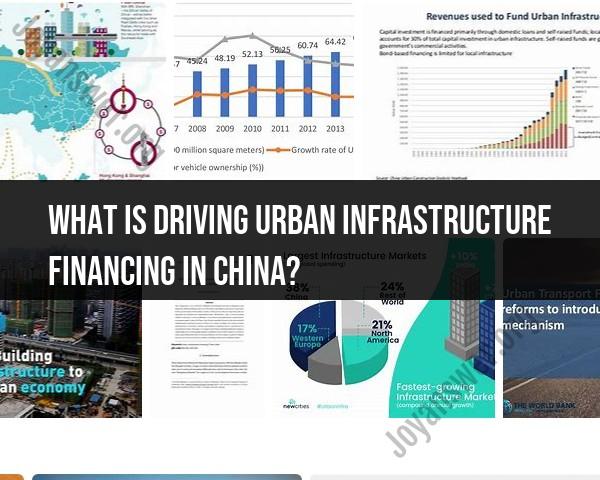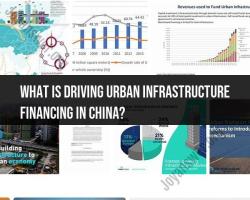What is driving urban infrastructure financing in China?
Urban infrastructure financing in China is driven by a combination of factors, strategies, and initiatives aimed at supporting the rapid urbanization and economic growth of the country. Several key elements contribute to the financing of urban infrastructure projects in China:
Government Investment: The Chinese government has been a major driver of urban infrastructure financing. Central and local governments allocate significant funds to finance the construction and maintenance of urban infrastructure, including transportation, water supply, sewage systems, and more. This government funding often comes from both national and local budgets.
Public-Private Partnerships (PPPs): China has increasingly turned to PPPs to finance urban infrastructure projects. These partnerships involve collaboration between government agencies and private sector entities to fund, develop, and operate infrastructure projects. PPPs can bring in private capital and expertise, reducing the burden on public finances.
State-Owned Enterprises (SOEs): Many state-owned enterprises in China are involved in urban infrastructure financing and development. SOEs, particularly those in sectors like construction, transportation, and utilities, play a significant role in implementing and funding large-scale infrastructure projects.
Bonds and Financial Instruments: Chinese cities and provinces often issue bonds to raise capital for infrastructure development. This includes municipal bonds, green bonds, and other financial instruments that attract investment from domestic and international investors.
Land-Based Financing: Land sales and land development fees provide a substantial source of revenue for urban infrastructure projects. Local governments often rely on land sales to fund new infrastructure development, especially in rapidly urbanizing areas.
Infrastructure Investment Funds: China has established various infrastructure investment funds, including the National Social Security Fund (NSSF) and the Silk Road Fund, which invest in infrastructure projects both domestically and internationally.
Foreign Investment: China actively seeks foreign investment in urban infrastructure projects, particularly under initiatives like the Belt and Road Initiative (BRI). This involves partnerships with foreign governments and international organizations to fund and develop infrastructure.
Innovative Financing Models: China has explored innovative financing models, such as the use of green finance and sustainable financing mechanisms to fund infrastructure projects that are environmentally friendly and energy-efficient.
Local Financing Initiatives: Many cities and regions in China have established their own financing initiatives and mechanisms to support urban infrastructure development. These initiatives may involve special economic zones or local investment promotion policies.
Technology and Efficiency Gains: The adoption of modern technologies, such as smart city solutions and digital infrastructure, not only enhances urban services but also contributes to efficient infrastructure financing and management.
Economic Growth and Urbanization: China's ongoing economic growth and urbanization drive the need for continued investment in urban infrastructure. Rapid urbanization leads to increased demand for transportation, utilities, housing, and other urban services.
Environmental and Sustainability Goals: China's focus on sustainability and environmental protection has led to investments in eco-friendly infrastructure projects, which often receive support and financing from both government and private sources.
In summary, the financing of urban infrastructure in China is a complex interplay of government policies, public and private sector collaboration, financial instruments, foreign investment, and innovative strategies. The country's commitment to urban development, economic growth, and environmental sustainability continues to fuel infrastructure financing initiatives.
Driving Urban Infrastructure Financing in China: Insights and Trends
China has invested heavily in urban infrastructure in recent decades, and this investment has played a key role in the country's rapid economic growth and urbanization. However, the demand for urban infrastructure investment continues to grow, and the Chinese government is facing challenges in financing this investment.
There are a number of insights and trends that can help to drive urban infrastructure financing in China. One important trend is the increasing role of the private sector in infrastructure investment. The Chinese government has encouraged private sector participation in infrastructure projects through a variety of measures, such as public-private partnerships (PPPs).
Another important trend is the development of new financial instruments for infrastructure financing. For example, the Chinese government has established a number of infrastructure investment funds, and it is also exploring the use of green bonds to finance sustainable infrastructure projects.
The Forces Shaping Infrastructure Investment in Chinese Cities
The forces shaping infrastructure investment in Chinese cities include:
- Economic growth: Economic growth is a key driver of infrastructure investment in Chinese cities. As the Chinese economy continues to grow, there is a growing demand for new and improved infrastructure.
- Urbanization: China is experiencing rapid urbanization, and this is also driving infrastructure investment. As more and more people move to cities, there is a need to invest in infrastructure such as transportation, energy, and water supply.
- Government policies: The Chinese government has made infrastructure investment a top priority. The government has provided financial support for infrastructure projects and has also created a favorable environment for private sector participation in infrastructure investment.
Financing Urban Development and Infrastructure Projects
There are a variety of ways to finance urban development and infrastructure projects. The most common sources of financing include:
- Government budgets: Government budgets are a major source of financing for urban development and infrastructure projects. However, the Chinese government is facing challenges in financing infrastructure investment, given the country's high debt levels.
- Bank loans: Bank loans are another important source of financing for urban development and infrastructure projects. However, banks are becoming more cautious about lending to local governments, given the risks of local government debt defaults.
- Public-private partnerships (PPPs): PPPs are a form of partnership between the public and private sectors. In a PPP, the private sector provides the financing and expertise for a project, while the government provides the land and other resources.
- Infrastructure investment funds: Infrastructure investment funds are a type of investment fund that invests in infrastructure projects. Infrastructure investment funds can be a good source of financing for large and complex infrastructure projects.
- Green bonds: Green bonds are a type of bond that is used to finance sustainable infrastructure projects. Green bonds are becoming increasingly popular in China, as the government encourages investment in sustainable infrastructure.
Public and Private Sectors in Urban Infrastructure Financing
Both the public and private sectors play important roles in urban infrastructure financing. The public sector provides financial support for infrastructure projects and creates a favorable environment for private sector participation in infrastructure investment. The private sector provides the financing and expertise for infrastructure projects.
The Chinese government is encouraging greater private sector participation in infrastructure investment. The government has introduced a number of measures to support private sector participation in infrastructure projects, such as PPPs and infrastructure investment funds.
Sustainable Infrastructure Finance Strategies in China
The Chinese government is committed to developing sustainable infrastructure. The government has introduced a number of policies to promote sustainable infrastructure investment, such as green bonds and the Green Finance Committee.
The Chinese government is also working to develop a sustainable infrastructure finance system. The government is working to create a market for sustainable infrastructure investment and to develop new financial instruments for financing sustainable infrastructure projects.
Conclusion
Driving urban infrastructure financing in China is a complex challenge. However, there are a number of insights and trends that can help to address this challenge. The increasing role of the private sector in infrastructure investment and the development of new financial instruments for infrastructure financing are two important trends that can help to drive urban infrastructure financing in China.


